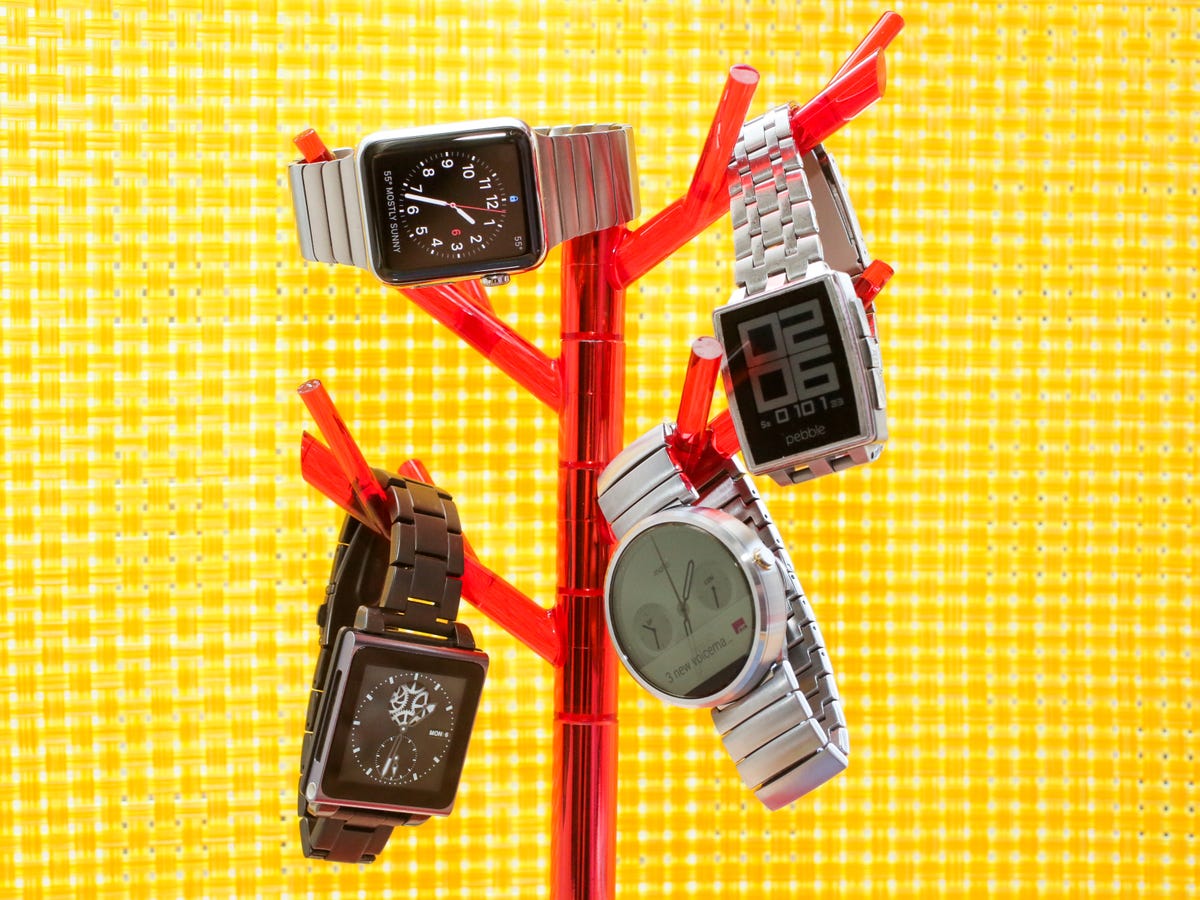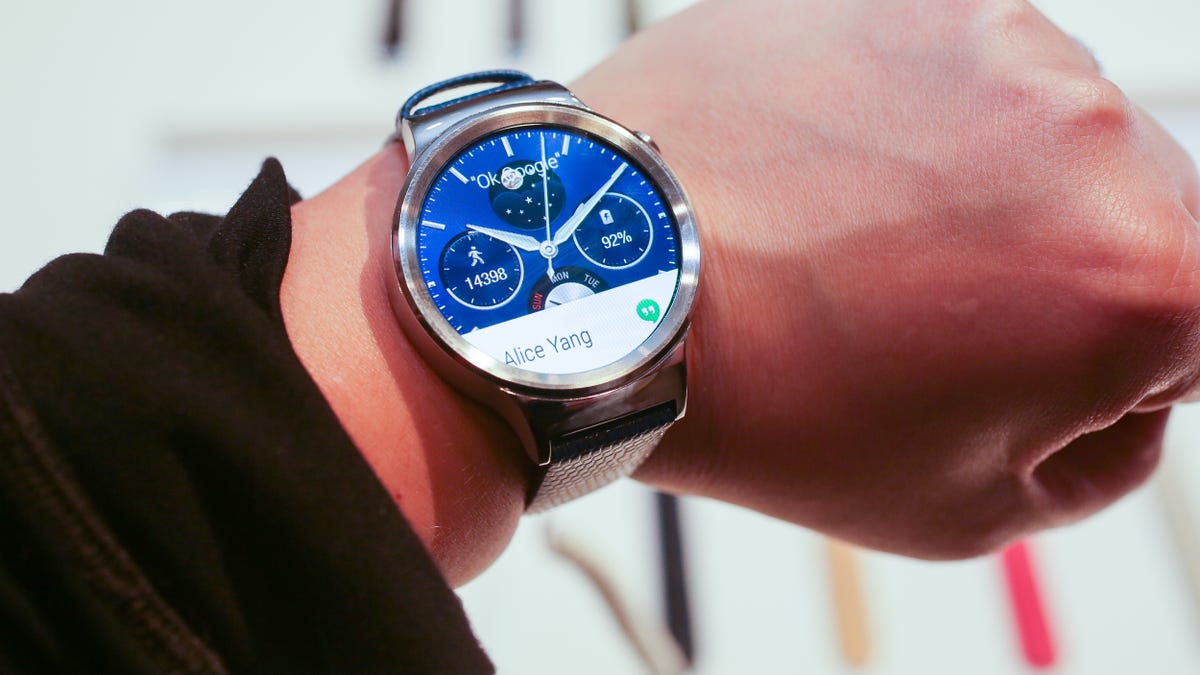
Sarah Tew/CNET
What is a smartwatch, and what can it do? The Apple Watch arrives in a landscape filled with things for your wrist. How does it stack up? Great in some ways, and not so wonderfully in others. Let’s look at the closest competition and see.
Pebble Watch
My personal favorite, the Pebble, is lean, mean and cheap. A plastic version costs just $99, while the Steel version is $100 more. In the UK, they’re £99 and £179 and in Australia, they’re AU$129 and AU$229.


Sarah Tew/CNET
Pebble works with iOS and Android, has a battery that lasts up to 7 days, is 5 ATM waterproof for swimming or showering and has an always-on screen. It added on-watch step-counting last year, and vibrates to indicate notifications, incoming calls or other actions.
It runs apps, but they’re bare-bones. It lacks a touchscreen: the Pebble only has buttons.
The display’s a more primitive black-and-white affair with limited pixel resolution. It doesn’t have a microphone or speaker.
A newer version, Pebble Time , arrives in May with a reflective color display, a microphone, and the potential for optional smart straps to add extra hardware functions. It costs $199, or $299 for the steel version (shown).
The Apple Watch , in comparison, runs far more apps, has a force-sensitive color touch screen, a speaker and microphone, has a heart rate monitor, works with Apple Pay for contactless payments, stores music, and has a more refined build quality. But its battery life is just a day, it isn’t as water resistant, it costs far more ($350 starting price), and only pairs with recent iPhones.
Android Wear
Google’s wearable tech watch platform has been out for about a year, and already has many watches and compatible apps under its belt. Android Wear watches have color touch displays, distinctive round (or, more traditional square) displays, many pricing and design options, and can run on any Android phone running Android 4.3 or later.

 Enlarge Image
Enlarge ImageJuan Garzón/CNET
Rumors suggest iOS compatibility might be on its way; that would be great to see. Google’s voice-command search services are helpful, and it’s easy to take dictation. Many apps cross-load onto the watch from Google Play.
Google Now notification and information cards get pushed to the watch predictively to assist you throughout the day. There are also lots of color watch faces available to download and install.
Some Android Wear watches have onboard GPS and heart-rate monitors, and upcoming ones will also have Wi-Fi. Battery life tends to last anywhere from 2 to 3 days.
Android Wear’s functions are limited to a particular set of functions: none of them have speakers, so you can’t make phone calls or hear alarms. Google’s Android Wear OS hides apps behind an ugly scrolling menu of suggested Google Now voice commands, rather than making apps easy to browse and tap. And Google Now cards aren’t always helpful.
Android Wear watches range from affordable ($199) to expensive ($300 or more). Onboard storage is limited to 4GB, while the Apple Watch has 6.2 GB of usable space (2GB for music).
The Apple Watch supports Apple Pay, Wi-Fi (provided your phone is still paired and on, too), and has a more advanced force-sensitive touchscreen, but it’s a lot more expensive for most configurations. But, both sizes of Apple Watch are smaller than the average Android Wear watch.
Battery life advantages currently go in Android Wear’s favor by at least a day, or more.


Now playing:
Watch this:
Apple Watch: Extremely ambitious, far from perfect
3:26
Samsung Gear
Samsung is an interesting case because, so far, it’s made both Android Wear watches (see above) and its own Samsung Gear line. The latter uses the company’s proprietary Tizen operating system. (The easy way to tell them apart: if the product has the word “Galaxy” in it, it’s Android Wear; if not, it’s Tizen.)


Sarah Tew/CNET
The most recent Samsung watch was the 2014 Gear S , a combination smartwatch and SIM card-enabled standalone phone.
It required its own data plan, but showed where smartwatches could go next as semi-independent wrist gadgets.
Samsung’s Gear watches are very feature-packed, like the Apple Watch: heart-rate monitoring, onboard speakers and mics for speakerphone calling on the watch, and onboard music storage and playback.
But Samsung’s software is uglier than Apple’s, it’s less intuitive, and the app library’s offerings that run on Samsung’s aforementioned Tizen software are scattershot at best, lacking many known big-name app brands.
Many people love Gear watches for their ability to take calls, read and respond to messages and be stylish companions for Samsung phones. These watches are Samsung phone-specific, meaning you’ll need one of a dozen-plus particular phones to pair it.
In some ways, the Apple Watch feels like a much more thought-out iPhone-exclusive version of the Gear watches, with far better software but a higher price and worse battery life.
After releasing six watches in rapid succession over the course of only a year (late 2013 through late 2014), Samsung has gone quiet on the smartwatch front. With that in mind, I’d steer clear of current models, on the presumption that a new-for-2015 Gear will be announced before year’s end.
Dedicated fitness bands: Fitbit Surge and more
There are fitness-specific watches like the Surge that track heart rate, record runs and even get some basic phone call and message notifications. Their advantages tend to be: more affordable ($250 for the Surge), better battery life (up to a week, typically), and good fitness software and app support.


Sarah Tew/CNET
The Apple Watch has some of the best onboard fitness software of any smartwatch, but its battery life limitations (a day or less) make it the opposite of a wear-it-all-the-time band like Fitbit or Jawbone offer. You can’t do sleep tracking on the Apple Watch, either, because you need to charge it each night.
Other wearables track heart rate continuously: the Apple Watch pings every 10 minutes or so, but not all the time. And it doesn’t have an always-on screen, or swim-friendly water resistance. The Surge can’t be worn while swimming, either, but it does have its own onboard GPS tracking.
The Apple Watch can also store music for workouts, something fitness bands just don’t do.
For smartwatches, this is just the beginning
That’s an overview of the current smartwatch and fitness band landscape — but it’s just a snapshot for early 2015. The market has already come a long way in just the past 18 months, and it’s only getting more competitive.


Sarah Tew/CNET
Beyond Apple — already, no doubt, planning next-generation Apple Watch models, expect Google, Microsoft , Jawbone, Fitbit and a host of others to have new models (and apps) in the next year.
And that doesn’t even include traditional watchmakers, like Swatch, which are also getting into the smartwatch game.
In other words, the smartwatch space in 2015 feels a lot like the smartphone market did eight or nine years ago. It’s just getting started, and the future landscape may be almost unrecognizable from what you see today.
Stay tuned.



